This article is about the simulator region.
For the government in SL, see Confederation of Democratic Simulators.
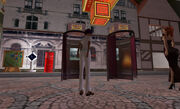
Voting booths for the July 2006 Election
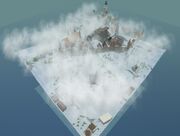
Neufreistadt, March 2007
Neufreistadt is an administrative region of an over-arching government in SL, called Confederation of Democratic Simulators (CDS), currently comprising Neufreistadt, Colonia Nova, Alpine Meadow, Locus Amoenus, Monastery and Friedsee. The city of Neufreistadt is modelled after a medieval Bavarian city with a surrounding valley. The city was formerly known as Neualtenburg (see History).
The land is mainly used for residential space, quite a lot of space is used for public buildings and there is land for commercial use too.
Among often quoted benefits of the remarkable feature of self-governance (through citizen participation) is that not only the 'chaos' of the mainland is absent but also that citizens can influence nearly every aspect of the sim's administration.
Self-governance[]
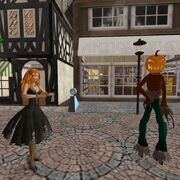
The Chancellor (right) talks with the (then) Dean of the Scientific Council (left). Oct. 2007
Besides the charming Bavarian looks, Neufreistadt is best known for its democratic government, run by the citizens themselves. Because the government (that spans multiple sims) is 'all-encompassing', and SL itself is almost unlimited too, it is difficult to give a short summary of all the things that this comes down to in the sim itself.
The main article about the government of Neufreistadt can be found here (e.g. it shows how citizens elect their representatives or participate in government), but below is a list to give an impression of the wide variety of topics that comes into play in a sim that's run in this way:
- Government itself
- Who does what to get things done, and making sure no one has unlimited power (checks and balances)
- Having simple rules, laws, a constitution and even the Universal Declaration of Human Rights
- Conflicts or unacceptable behaviour and resolving it in a fair way
- Encouraging creativity, engagement and activity for cool sims (!)
- Businesses, how to encourage them and keep it customer friendly too
- The philosophical
- Simplicity V. management in detail (keep it fun, don't overintellectualize V. if you do it, do it really good)
- RL expertise for certain jobs V. maximizing SL participation
History[]
Since its inception as a group-owned tiered mainland sim in Anzere, the government model followed a rather long discussion period held mostly on the Linden Lab forums, for a period of about 10 weeks and involving around 20 people interested in jointly presenting a project to Haney Linden, who raised a challenge on Aug 31st, 2004, for projects to "preserve the snow sims". A proposal based on the forum discussions was elaborated by Ulrika Zugzwang and presented by her and Kendra Bancroft for appreciation; after Haney approved it, the forum discussion moved towards establishing a constitution, a provisory government, and a layout of the city to be built, inspired on the Bavarian city of Rothenburg, and adhering to the "theme" of a medieval Bavarian setting.
Haney's proposal allowed the group to establish themselves on an area in Anzere of about 1/3 of the sim, but getting access to the total available number of prims, and the land was leased to the group for four months, assuming that tier was paid for it over that period (the land could not be resold). Most of the work during those first four months concentrated on finding people to get all the buildings done, get event hosters, attract artists, and (naturally!) politicians, setting up some shops for selling souvenirs, and preparing things for the first elections in Second Life. Membership was loosely based on "willingness to help" (and be part of the group).
After the lease was renewed for a further four months, there was now the first elected government in place, regularly meeting and establishing their first laws. Most of the discussion during that first term was mostly to raise funds to continue to pay for the lease after its second term. After abolishing taxes (in order to attract more merchants), an attempt was made to establish a casino as a regular source of income, but it quickly became obvious that no model at the time allowed the financial safety necessary to keep the project going.
Linden Lab removed the support to any similar projects after much public claims of favoritism, and a decision was made to move the whole city into a private island, called "Neualtenburg". At this time, the whole model of financing the costs of a private island was changed. Citizens were (re)defined as owning deeded land in the city, and they paid a monthly fee that would contribute towards paying the private land to LL. In order to raise some initial cash until a reasonable amount of plots were sold, the city emitted a series of bonds (that were redeemed after a year), but after a few months (taking into account that now the whole land outside the city walls was available for sale), it was pretty clear that this model would work rather well.
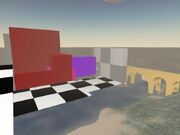
Colonia Nova online! October 2006
In the beginning of 2006, the workings of the judicial system of Neufreistadt were put to a test after being threatened to its integrity by Ulrika Zugzwang, one of the founders, who launched all types of attacks to the city in order to destroy it — physically, by deleting buildings on the common ground, and other people's objects; psychologically, through a well-elaborated campaign of misinformation, public defamation on all public channels (SL forums, emails, in-world meetings, wikis, blogs, interviews to the SL media), and pseudo-legalistic threats. Public hearings on the issue were discredited and even used as further tools to break the community apart.
By mid-June 2006, the citizens, more united than ever, once and for all broke free by replacing all structures with better content, and finally changing the name of the city to Neufreistadt. The lesson learned in this process is that there is no place in this self-governed community for "unwritten agreements", no matter how old and respected a citizen might be. Besides a new name for the city, a name for the over-arching government was also chosen: "Confederation of Democratic Simulators" (CDS); the second sim, Colonia Nova, would be brought online soon after this, in October 2006.
Also, in late 2006, there was a heated debate about a new Judicial Branch in addition to the existing government, a summary can be found on the CDS wiki page (See Former Branches of Government).

Oktoberfest 2007, during a quiet moment
Highlights in the life of the city of Neufreistadt were its immensely successful events ('04 and '07 Oktoberfest, Expo, Winter Holidays), participation in major SL events like the Dreams Community Fair (2006) and the Second Life Third Anniversary, and the reopening of Neufreistadt's Museum of Contemporary Art (2007). Also a highlight was a big "worker's strike" during the summer of 2005. At that time, an agreement was made that all subsequent work would be paid under contracts between the government and the Guild (see below).
While the CDS continued to expand, in several cases with better urban planning and higher-quality texturing, the unique quaintness of Neufreistadt still appeals to a lot of the citizens. The sim, with content developed mostly in 2004, feels old and worn out, like a real city with a lot of history. Unlike the other CDS sims, where most activity is indoors and at private places or public buildings, Neufreistadt has its life on the streets, most specifically at its Marktplatz — the marketplace — which is the centre of the city (and the location for the telehub). Framed by the Kirche (Church) on one side, the Rathaus (Town Hall) on the other side, and small, exquisite shops in-between, the Marktplatz is where the annual Oktoberfest is held, as well as the Winter Holiday parties, and the Mayfest, as well as several other events around the year. Traditionally, every new term, the newly elected members of the Representative Assembly also parade on the Marktplatz towards the Rathaus, followed by all the citizens.
Under the Marktplatz, in the secret places that crawl beneath the city and which were once a private joke created by Kendra Bancroft, who imagined a complex network of tunnels and pipes interconnecting the city's underground (a project that quickly exhausted all prims and had to be abandoned), there is a huge Football Stadium, where the four teams of the CDS (one for each sim) compete in the CDS League and play against teams from the Second Football League. Formerly this space under the Marktplace had several uses — from a private workshop for the Guild, to hosting the Secret Tiny City for a while, to a simply empty space, and now a football field.
The city has lots of curiosities to explore, both inside its walls and outside on the valley; most visitors and even several citizens are not aware of the many "Easter eggs" hidden all over the place and hard to find. They're the very stuff of legend and myth.
Culture, Arts and Education[]

The MoCA (2007)
The Neufreistadt Museum of Contemporary Art[]
The MoCA (formally MoCA Society) is a non profit NGO with a CDS government approved charter which focusses on cultural aims within the CDS and Neufreistadt in particular, allowing it to draw on resources from public land (prims and display space).
As of June 2007 the curator is Delia Lake. The MoCA had its reopening in March 2007 as well as several events. The MoCA Society, open to all citizens, has its own alt account, MoCAso Oh, to archive the works that aren't displayed, and to keep the MoCA funds totally separate.
The modern looking MoCA building was built by Keltrien Baker.
Noteworthy places[]
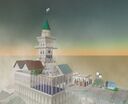
The Schloss
The Schloss (Castle)[]
Somewhere early in 2006, Kendra Bancroft was commissioned to build the Schloss for Ulrika Zugzwang on her privatly owned parcel. But due to the upheavals between the founders and the rest of the population, it never got finished and was left in a very unfinished state.
In August 2006, Sudane Erato did its first renovation by adding the balcony with dancing balls, where subsequently a successful ball (event) was held. But a lot of 'plywood' remained, so early 2007 Samantha Fuller began a second round of renovations: Using better textures, beautifying the tower and adding a transparent dome on the Schloss ballroom.
In 2012, Sudane Erato and Rosie Gray built completed construction of a new Schloss. Sudane Erato constructed the structure and Rosie Gray applied the textures, many of which she created especially for this project.
The Kirche (Church)[]

Kirche Interior

Kirche Exterior

Kirche Interior
The most developed of the shared structures in the city, the church, was built over the course of six months by BladeDancer Pendragon. It is one of the oldest buildings in Neufreistadt. Rich in detail, it towers over the city both in size and complexity, providing something new to discover every visit. The guardian of the church, Gwyneth Llewelyn, holds weekly meetings there to discuss religion, often from an open minded, philosophical stance.
In 2011-12, Rosie Gray redesigned and rebuilt a new Kirche. This amazing structure is designed for spiritual and secular events. It is available for all to use.
The Biergarten[]
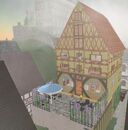
The Biergarten
The Biergarten (officially Urusulas Gaststätte und Biergarten), is Neufreistadt's publicly owned inn, with a small 'Beer garden' attached. It was built by Urusula Zapata, and furnished by Kendra Bancroft. It was fully redesigned by Moon Adamant (exteriors and interiors) with some help from volunteers in the Summer of 2008, but still keeping within the spirit of the old building.
The Biergarten is sometimes used by the Scientific Council but it's available to anyone who wants to hold a meeting or presentation, as long as Chancellor gives her/his OK for it. It used to be a meeting place for the Thinkers group in 2006 and is sometimes used for campaigning purposes (since it's considered a "neutral" place).
The Biergarten was renovated recently by Rosie Gray and still retains the charm of the traditional structure. The upper story of the Biergarten is additional presentation space for our local artists.
The Rathaus (Town Hall)[]

The Rathaus
The Rathaus is the historical seat of government of the Confederation of Democratic Simulators since the old "Senate Tower" was demolished to make space for the Schloss. It is a two-room building at the Marktplatz. The ground floor has the Registry for Neufreistadt — the place where citizens living in Neufreistadt pay their monthly fees, and an old display of the Nota Bene automatic notary system that sadly doesn't work any more. The first floor hosts the meeting place for the Representative Assembly. Since the Confederation grew in size and population, the Representative Assembly now meets exclusively at the Praetorium in Colonia Nova and the Rathaus is awaiting a new role.
Built by Kendra Bancroft, serving for well over a decade, it was completely remodelled in the early 2020s, leaving the Clock Tower as her oldest building in the city.
Historical dates[]
- July 31 2004 — Haney Linden launches project for communities wishing to preserve the snow sims
- September 12 2004 — Proposal Approved
- September 20 2004 — Land in Anzere
- November 14 2004 — Provisional Government
- January 15-16 2005 — First Elections
- January 30 2005 — First Representative Assembly Meeting
- April 21 2005 — First private region, named "Neualtenburg", goes online
- August 7 2005 — Guild Master Kendra Bancroft calls Guild general strike
- June 18 2006 — Name Change to Neufreistadt
- October 15 2006 — Second region, Colonia Nova, opens
- November 22 2007 — Third region, Alpine Meadow, online
- September 1 2008 — Fourth region, Locus Amoenus, opens
- July 2009 — Fifth region, Monastery, opens
- December 2015 — Sixth region, Friedsee, opens
References[]
- Official Site of the CDS
- Facebook page for the CDS
- Official Forums of Neufreistadt and the CDS
- Photos from the CDS sims (est. Nov 5, 2007)
- Blog article: Some thoughts on why governments in SL are so hard to implement
- Blog article: SL's most hated project
- A promotional video for the City of Neualtenburg done in September 2005 by Kendra Bancroft